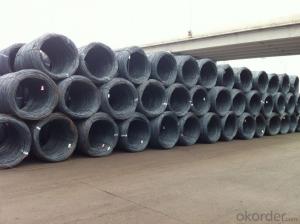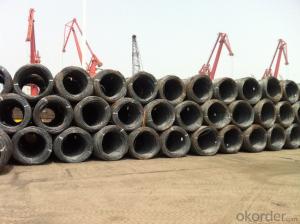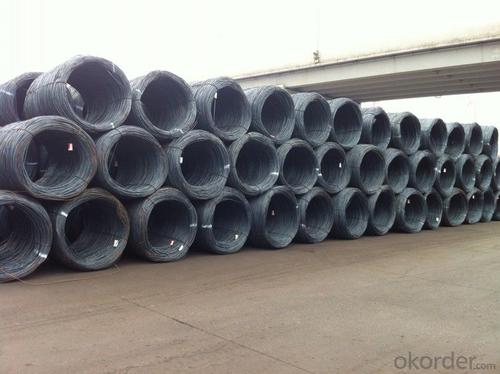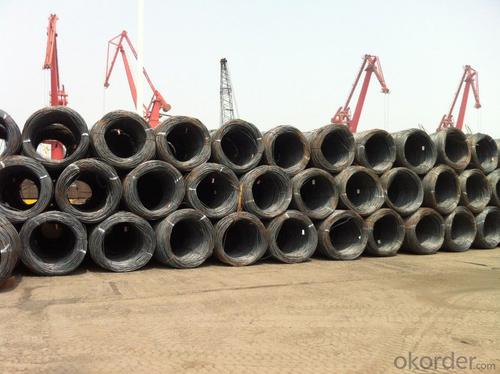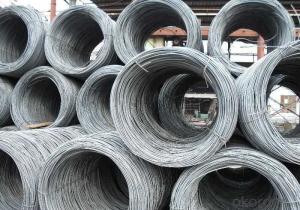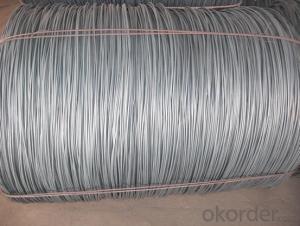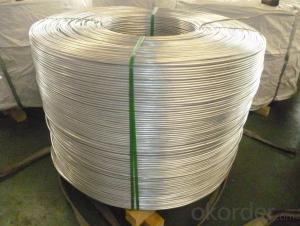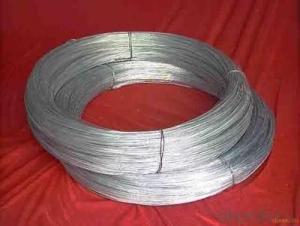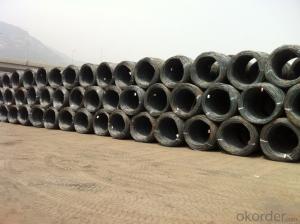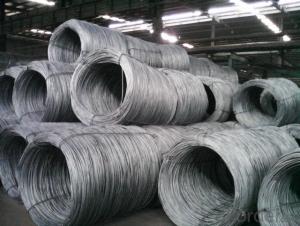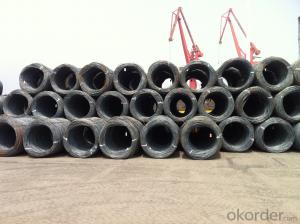SAE1008 Wire Rods with Best Quality and Price
- Loading Port:
- Tianjin
- Payment Terms:
- TT OR LC
- Min Order Qty:
- 25 m.t.
- Supply Capability:
- 20000 m.t./month
OKorder Service Pledge
OKorder Financial Service
You Might Also Like
Specification
Grade: SAE1008 Standard: ASTM
Diameter: 5.5mm, 6.5mm, 7mm, 8mm, 9mm, 10mm, 11mm, 12mm
Alloy or Not: Alloy
Technique: Hot Rolled Place of Origin: China Mainland
Chemical Composition:
Please kindly find our chemistry of our material based on SAE1008 as below for your reference:
Grade | Chemical Composition (%) | |||||
C | Mn | S | P | Si | B | |
SAE1008 | 0.10max | 0.30-0.50 | 0.050max | 0.040max | 0.30max | 0.0008min |
Mechanical properties | ||||||
Yield strength(N/mm2) | Tensile strength(N/mm2) | Elongation (%) | ||||
≥195 | 350-380 | ≥32 | ||||
Usage and Applications of Wire Rod:
After hot-rolled the products shaped into coil and delivery as finished product, including round, square,rectangular, hexagonal and so on. Since most of the products are round, it is generally called wire rod. Carbon steel wire rod is widely used in construction and manufacturing. Carbon steel wire rod is mainly used for reinforcement of reinforced concrete and welded structure or reprocessed (roberts , nail, etc.) materials, especially used to produce wire drawing, welding electrode, nails, spring, electronic, precise machinery parts and so on.
Packaging & Delivery of Wire Rod:
Packaging Detail: products are packed in coil and then shipped by container or bulk vessel
Each coil weight: About 2.05MT
Delivery Detail: within 45 days after received deposit or LC.
Label: to be specified by customer, generally, each bundle has 1-2 labels
Trade terms: FOB, CFR, CIF
FAQ:
Q1: How soon can we receive the product after purchasement?
A1: Within three days of placing an order, we will begin production. The specific shipping date is dependent upon international and government factors, but is typically one month.
Q2: How do you guarantee the quality of our products?
A2: We have established an advanced quality management system which conducts strict quality tests at every step, from raw materials to the final product. At the same time, we provide extensive follow-up service assurances as required.
Q1: Why buy Materials & Equipment from OKorder.com?
A1: All products offered by OKorder.com are carefully selected from China's most reliable manufacturing enterprises. Through its ISO certifications, OKorder.com adheres to the highest standards and a commitment to supply chain safety and customer satisfaction.
Images of Wire Rod
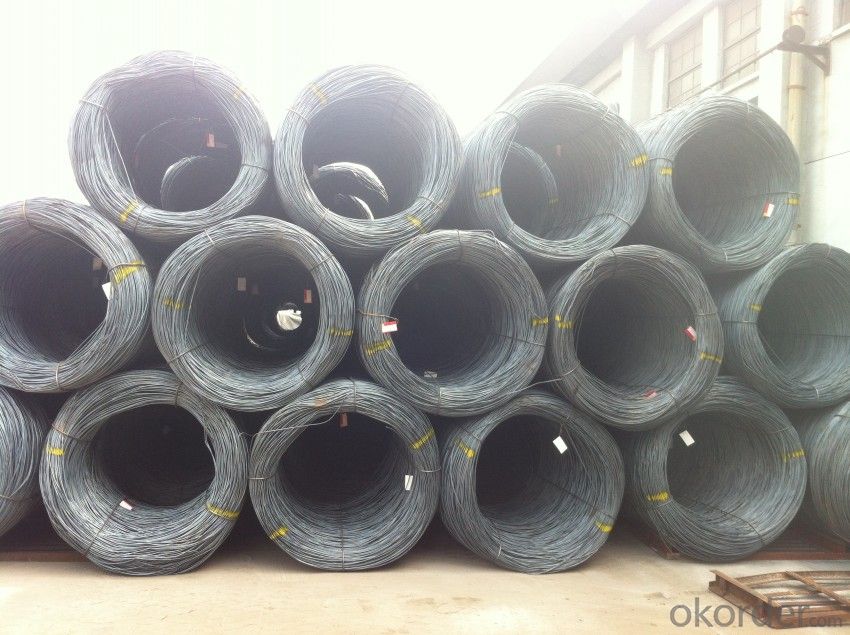
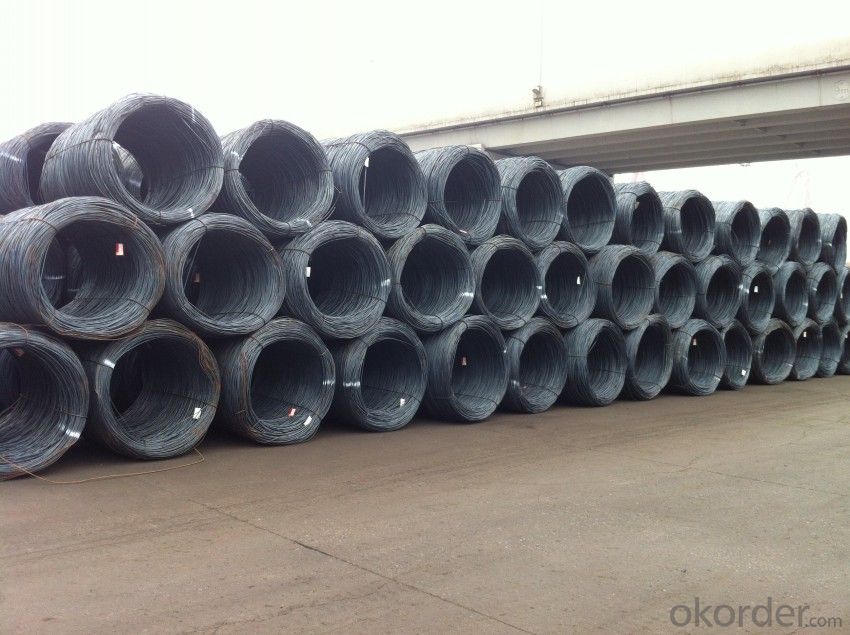
- Q: How is steel wire rod used in the manufacturing of wire for aerospace applications?
- The manufacturing of wire for aerospace applications heavily relies on steel wire rod. This component is crucial and serves as the primary raw material for producing high-quality wires that meet the demanding requirements of the aerospace industry. To enhance the mechanical properties and ensure purity, the steel wire rod undergoes a series of processes like cleaning, descaling, and heat treatment. These processes effectively remove any impurities or contaminants that could negatively affect the wire's performance or structural integrity. Once the steel wire rod is prepared, it is drawn through a series of dies multiple times to decrease its diameter and increase its length. This drawing process is carefully monitored to maintain dimensional accuracy and consistent quality, ultimately achieving the desired wire thickness and strength. Following the drawing process, the wire undergoes additional treatments such as annealing or stress relieving to improve its ductility and resistance to fatigue. These treatments are crucial for aerospace applications, as the wire will experience extreme forces and temperature variations. The manufactured wire then undergoes rigorous testing and quality control measures to ensure it meets the stringent standards set by the aerospace industry. These tests involve examining the wire's mechanical properties, surface finish, and dimensional accuracy. Once the wire successfully passes all the necessary tests, it is ready for use in various aerospace applications. Wire manufactured from steel wire rod is commonly employed in aircraft control cables, wiring harnesses, fasteners, springs, and other critical components. Its high strength, durability, and corrosion resistance make it well-suited for withstanding the demanding conditions of aerospace environments. In conclusion, steel wire rod is a crucial component in the manufacturing of wire for aerospace applications. It undergoes various processes, drawing, and treatments to enhance its properties and achieve the desired wire dimensions and strength. Thorough testing ensures that the resulting wire meets aerospace standards. Ultimately, this wire plays a significant role in critical aerospace components, contributing to the safety and performance of aerospace systems.
- Q: What are the different types of steel wire rod heat treatments?
- Steel wire rods can undergo various heat treatments, each serving a specific purpose and aiming for desired outcomes. The treatments available include: 1. Annealing: By heating the steel wire rods to a specific temperature and gradually cooling them, internal stresses are relieved, enhancing their ductility and toughness. 2. Normalizing: Similar to annealing, normalizing involves heating the steel wire rods to a specific temperature and cooling them in still air. This treatment refines the grain structure, resulting in a more uniform steel with improved mechanical properties. 3. Quenching and tempering: This two-step process entails heating the steel wire rods to a high temperature and rapidly cooling them in a quenching medium like water or oil. It hardens the rods, making them stronger and more resistant to wear and deformation. After quenching, reheating at a lower temperature reduces brittleness and enhances toughness. 4. Stress relieving: By heating the steel wire rods to a specific temperature and gradually cooling them, residual stresses from the manufacturing process are eliminated. This treatment prevents distortion and cracking in the rods. 5. Martempering: A variation of quenching and tempering, martempering involves controlled quenching of the steel wire rods to a temperature just above the martensite start temperature. They are then held at that temperature until internal temperature is uniform. This process creates a more uniform microstructure, minimizing the risk of distortion or cracking. 6. Austempering: This treatment includes quenching the steel wire rods to a temperature just above the martensite start temperature and holding them at that temperature until the austenite transforms into bainite. Austempering provides a combination of high strength and good toughness, making it suitable for applications requiring both properties. These represent some of the commonly employed heat treatments for steel wire rods. The choice of treatment depends on the desired properties and performance requirements of the end product.
- Q: What are the common applications of low carbon and oil tempered steel wire rod?
- Due to their unique properties, low carbon and oil tempered steel wire rod find a wide range of applications. These types of steel wire rod are commonly utilized in the following areas: 1. Springs: The automotive industry extensively utilizes low carbon and oil tempered steel wire rod in the production of springs. These springs require high tensile strength, excellent resistance to fatigue, and good flexibility, all of which are provided by these steel wire rods. 2. Wire ropes: Various industries, such as mining, construction, and transportation, rely on low carbon and oil tempered steel wire rod for the production of wire ropes. These steel wire rods possess high tensile strength and durability, making them suitable for withstanding heavy loads and harsh conditions. 3. Fasteners: Low carbon and oil tempered steel wire rod are commonly employed in the manufacturing of fasteners like bolts, nuts, and screws. These steel wire rods offer the necessary strength and toughness required for fasteners to withstand high loads and prevent failure. 4. Wire meshes: In industries such as agriculture, construction, and filtration, low carbon and oil tempered steel wire rod are utilized in the production of wire meshes. These steel wire rods exhibit excellent corrosion resistance and structural stability, making them ideal for applications where strength and durability are crucial. 5. Automotive components: Low carbon and oil tempered steel wire rod are utilized in the production of various automotive components, including seat frames, suspension systems, and brake springs. These steel wire rods provide the required strength, flexibility, and resistance to wear, ensuring the safety and performance of these automotive parts. Overall, low carbon and oil tempered steel wire rod have diverse applications across industries such as automotive, construction, mining, and manufacturing. These applications necessitate strength, durability, and flexibility.
- Q: How is steel wire rod classified based on its chemical composition?
- Steel wire rod is classified based on its chemical composition into different grades or types. The classification is primarily determined by the levels of carbon and alloying elements present in the steel. Low carbon steel wire rod, also known as mild steel, typically contains a carbon content ranging from 0.05% to 0.25%. This type of steel is often used for general-purpose applications such as construction, automotive, and machinery. Medium carbon steel wire rod contains a higher carbon content, usually between 0.25% and 0.60%. This grade of steel offers increased strength and hardness, making it suitable for applications that require higher tensile strength, such as springs, wires, and cables. High carbon steel wire rod contains a carbon content of over 0.60%. This grade of steel is known for its exceptional strength and hardness. It is commonly used in the manufacturing of high-strength wires, guitar strings, and cutting tools. Alloy steel wire rod is composed of multiple alloying elements such as chromium, nickel, manganese, or molybdenum, in addition to carbon. These alloying elements enhance specific properties of the steel, such as corrosion resistance, heat resistance, or wear resistance. Alloy steel wire rod is often used in specialized applications such as automotive components, fasteners, and machinery parts. In summary, steel wire rod is classified based on its chemical composition, with varying carbon and alloying element levels determining its specific grade or type. This classification helps in selecting the appropriate steel wire rod for specific applications based on the desired mechanical properties and performance requirements.
- Q: How is the weldability of steel wire rod evaluated?
- The weldability of steel wire rod is typically evaluated through various tests and assessments such as bend tests, tensile tests, and Charpy impact tests. These tests help determine the weldability characteristics of the steel wire rod, including its ability to withstand welding processes without developing defects or cracks. Additionally, the chemical composition, microstructure, and mechanical properties of the steel wire rod are also considered in evaluating its weldability.
- Q: What are the different types of steel wire rod finishes for improved impact resistance?
- There are several types of steel wire rod finishes that can be applied to improve impact resistance. Some common finishes include galvanized, epoxy coated, and stainless steel. These finishes provide a protective layer that enhances the wire rod's ability to withstand impact and prevent damage.
- Q: What are the different surface cleaning methods used for steel wire rod?
- There are several surface cleaning methods commonly used for steel wire rod, including mechanical cleaning, chemical cleaning, and electrolytic cleaning. Mechanical cleaning involves using abrasive materials or equipment to physically remove dirt, rust, and other contaminants from the surface of the wire rod. Chemical cleaning involves using chemical solvents or cleaners to dissolve or loosen dirt and contaminants, which can then be rinsed or wiped away. Electrolytic cleaning utilizes an electrical current and an electrolyte solution to remove surface impurities through a process called electrochemical cleaning. Each method has its own advantages and is chosen based on the specific requirements and conditions of the steel wire rod.
- Q: How is steel wire rod used in the production of wire for mattress springs?
- Steel wire rod is a crucial component in the production of wire for mattress springs. It serves as the primary raw material that is used to create the strong and durable wire required for mattress springs. To begin the manufacturing process, steel wire rod is first carefully selected based on its desired properties, such as its tensile strength, flexibility, and resistance to corrosion. The rod is then subjected to a series of processes to transform it into wire suitable for mattress springs. The first step involves heating the steel wire rod and passing it through a series of dies to progressively reduce its diameter. This process, known as wire drawing, helps refine the wire's mechanical properties and ensures uniformity in its thickness. Once the wire has been drawn to the desired diameter, it undergoes further treatment to enhance its strength and resilience. This may involve heat treatment processes like annealing or quenching, which help to improve the wire's flexibility and resistance to fatigue. After the wire has been treated, it is coiled onto spools or reels, ready to be used in the manufacturing of mattress springs. The wire is then fed into specialized spring-making machinery, where it is formed into the required shape and size. These machines use a combination of bending, coiling, and twisting movements to create the intricate spring designs commonly found in mattresses. The high-quality steel wire rod used in the production of wire for mattress springs ensures that the springs are strong, durable, and capable of withstanding the constant pressure and weight applied to them. This results in a mattress that offers excellent support and comfort to the sleeper. In summary, steel wire rod plays a critical role in the production of wire for mattress springs. It undergoes various processes to refine its properties and is then shaped into the required form to create sturdy and resilient springs. This ensures that mattresses made with these springs offer superior support and durability to users.
- Q: How is steel wire rod tested for corrosion resistance?
- Steel wire rod is typically tested for corrosion resistance using various methods. One common approach is conducting salt spray tests, where the rod is exposed to a controlled saltwater mist for a specific period. Another method involves immersing the rod in a corrosive solution, such as acid, to evaluate its resistance. Additionally, electrochemical tests, like the polarization resistance technique, can be performed to assess the rod's corrosion behavior. These tests help determine the durability and suitability of steel wire rods in corrosive environments.
- Q: What are the different types of steel wire rod surface cleaning methods for wire galvanizing?
- There are several different types of steel wire rod surface cleaning methods for wire galvanizing. These include mechanical cleaning methods such as brushing or shot blasting, chemical cleaning methods such as pickling or acid cleaning, and electrolytic cleaning methods. Each method has its advantages and is chosen based on the specific requirements and conditions of the galvanizing process.
Send your message to us
SAE1008 Wire Rods with Best Quality and Price
- Loading Port:
- Tianjin
- Payment Terms:
- TT OR LC
- Min Order Qty:
- 25 m.t.
- Supply Capability:
- 20000 m.t./month
OKorder Service Pledge
OKorder Financial Service
Similar products
Hot products
Hot Searches
Related keywords
